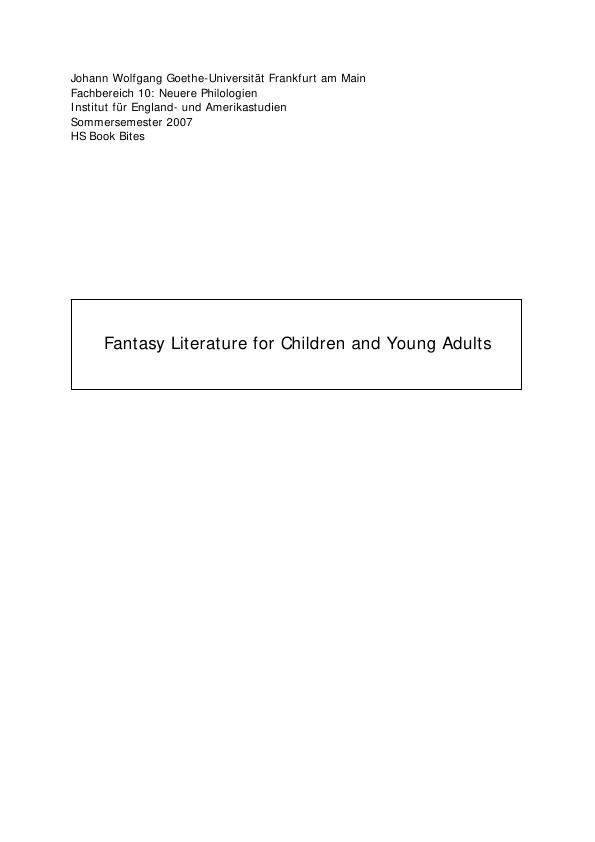1. Introduction
This paper presents the fields of Children’s and Young Adult Literature , Fantasy Literature and both fields in context. It will firstly discuss different approaches to these fields and specify them with a description of their historical developments – especially in Great Britain, the US and Germany. The focus will lie on a specific literary piece of work – the “Harry Potter” series, containing 7 volumes, written by Joanne K. Rowling, and firstly published originally in England in 1997. This series shall be applied to the theoretical background of fantastic ChL and YAL, so that motifs, figures, narrating techniques, and intentions are considered. The paper will conclude with a justification about what “Harry Potter” really is in a literary sense: A work of fantastic ChL and YAL.
2. What are „Children’s Literature“ and „Young Adult Literature“?
2.1 Definitions
Both terms “Children’s Literature” and “Young Adult Literature” are ambiguous and thus not very easy to define. For instance, one may ask, whether ChL is written by children, read by children, written about children, written about what interests children, or written for children. One might generally answer that the notion of “Children’s Literature” includes a bit of everything (except the first aspect because children usually do not write literature).
Hunt (1996: 17) also refers to these controversies when attempting to define the term. Firstly, he puts it in rather general words: “it is a category of books the existence of which absolutely depends on supposed relationships with a particular reading audience: children.” This statement defines the target group of ChL what means that Hunt sees it as literature which is read by children. However, this definition does not clarify the notion regarding the characteristics of its field. Many critiques say that the term includes “books which are good for children and most particularly good in terms of emotional and moral values” (Hunt, 1996: 17). But what are emotionally and morally good values, and who decides what they are? This leads to the question, whether ChL is specifically written for children. In this case, authors of such literature decide what is good as well as the parents or teachers who decide to let children read it.
Inhaltsverzeichnis (Table of Contents)
- Introduction
- What are „Children's Literature“ and „Young Adult Literature“?
- Definitions
- Historical developments in Great Britain, USA and Germany
- What are \"Fantasy\" and \"Fantasy Literature\"?
- Definitions
- Sub-genres of Fantasy Literature
- Allegorical Fantasy and Literary Fairy Tales
- Animal Fantasy
- Ghost Fantasy
- Alternate Worlds or Histories
- Myth Fantasy
- Humorous Fantasy
- Magic Adventure Fantasy
- Time Travel Fantasy
- Witchcraft and Sorcery Fantasy
- Development of Fantasy Literature for children and young adults in Great Britain, the United States and Germany
- Analysis of fantastic children's and young adult literature
- Motifs
- Figures
- Narrating techniques
- Intentions, functions and perception
- Conclusion
Zielsetzung und Themenschwerpunkte (Objectives and Key Themes)
This paper aims to provide an overview of the fields of Children’s and Young Adult Literature, Fantasy Literature, and how they intersect. The analysis focuses on the "Harry Potter" series by Joanne K. Rowling, examining its characteristics within the theoretical framework of children's and young adult fantasy literature.
- Defining the terms "Children's Literature" and "Young Adult Literature" and their historical development.
- Exploring the sub-genres of Fantasy Literature, specifically in the context of children and young adults.
- Analyzing key motifs, figures, and narrative techniques found in fantastic children's and young adult literature, using the "Harry Potter" series as an example.
- Exploring the intentions, functions, and perceptions of fantastic children's and young adult literature.
- Determining the literary significance of the "Harry Potter" series within the context of children's and young adult fantasy literature.
Zusammenfassung der Kapitel (Chapter Summaries)
- Introduction: This chapter introduces the topic of Children’s and Young Adult Literature, Fantasy Literature, and the intersection of these fields. The focus of the paper, the "Harry Potter" series, is presented as a case study to explore these themes.
- What are „Children's Literature“ and „Young Adult Literature“?: This chapter delves into the ambiguity of defining "Children's Literature" and "Young Adult Literature," exploring various perspectives on their characteristics and target audiences. It examines the historical development of these genres in Great Britain, the United States, and Germany, highlighting key milestones and trends.
- What are \"Fantasy\" and \"Fantasy Literature\"?: This chapter provides a definition of "Fantasy" and "Fantasy Literature," outlining the key elements and characteristics that define this genre. It then explores various sub-genres of Fantasy Literature, including allegorical fantasy, animal fantasy, ghost fantasy, alternate worlds, myth fantasy, humorous fantasy, magic adventure fantasy, time travel fantasy, and witchcraft and sorcery fantasy.
- Development of Fantasy Literature for children and young adults in Great Britain, the United States and Germany: This chapter investigates the historical development of Fantasy Literature specifically for children and young adults, focusing on key periods and trends in Great Britain, the United States, and Germany.
- Analysis of fantastic children's and young adult literature: This chapter focuses on examining motifs, figures, and narrative techniques commonly found in fantastic children's and young adult literature. This section will likely use the "Harry Potter" series as a concrete example to illustrate these elements.
Schlüsselwörter (Keywords)
This paper explores the rich world of children's and young adult fantasy literature, using "Harry Potter" as a case study. Key topics and concepts explored include the definition of "Children's Literature" and "Young Adult Literature," the sub-genres of Fantasy Literature, the historical development of these genres, the analysis of motifs, figures, and narrative techniques in fantastical works, and the exploration of the intentions, functions, and perceptions of this genre.
- Citation du texte
- Evelyn Schmitz (Auteur), 2007, Fantasy Literature for Children and Young Adults, Munich, GRIN Verlag, https://www.grin.com/document/87507



